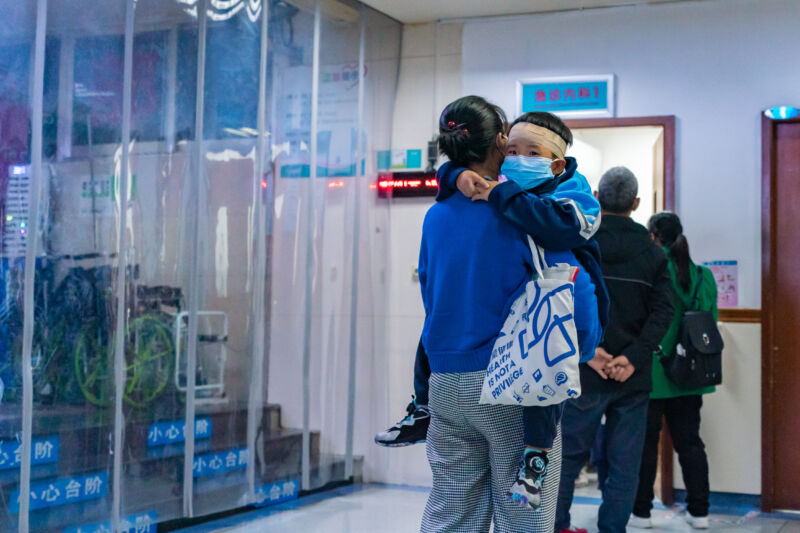
Last week, news stories and a posting on an infectious disease surveillance system raised fears that another novel respiratory pathogen with pandemic potential was mushrooming in northern areas of China—namely Beijing and Liaoning province. The reports referenced “undiagnosed pneumonia” in “clusters” of children, hospitals that were “overwhelmed,” and parents who were questioning whether “authorities were covering up the epidemic.”
But, rather than a sequel to the COVID-19 pandemic, the situation appears to be merely a side effect of it. According to independent experts and the World Health Organization, it’s most likely that China is now experiencing a roaring comeback of a mix of common respiratory infections that were muted during the global health crisis. Many other countries experienced the same surges in the past year or two, including the US. As with the other countries, the wave of infection in China is mostly affecting children, who were less exposed to all sorts of pathogens amid the health restrictions, leaving them more vulnerable to infections now.
The global explosion of COVID-19 transmission and subsequent pandemic health measures severely disrupted common cycles of many infectious diseases worldwide, knocking seasonal respiratory infections like adenoviruses and RSV (respiratory syncytial virus) off their annual cycles. In the US, the 2020-2021 flu season was virtually nonexistent, for instance. But, as the novel coronavirus abated and restrictions lifted, those pathogens vigorously returned. (The US also experienced early and intense peaks of RSV and flu last year.)
China only lifted its strict zero-COVID policy at the end of 2022. Thus, this is the first year the country is heading into a respiratory transmission season without widespread restrictions.
“This phenomenon of ‘lockdown exit’ waves of respiratory infections is sometimes referred to as ‘immunity debt,'” Francois Balloux, director of the University College London’s Genetics Institute, said in a media statement. He noted that the UK and other countries also saw such waves. But, he continued, “Since China experienced a far longer and harsher lockdown than essentially any other country on Earth, it was anticipated that those ‘lockdown exit’ waves could be substantial in China. Unless new evidence emerged, there is no reason to suspect the emergence of a novel pathogen.”
A wave, not clusters
Last week, the WHO—which faced severe criticism for its early handling of the COVID-19 pandemic and its relationship with China—requested more information on China’s surge in respiratory infections in children. On November 23, the United Nations agency held a teleconference with various Chinese health authorities to go through the requested data and ask questions. In a report of the meeting, the WHO said that the data indicated “an increase in outpatient consultations and hospital admissions of children due to Mycoplasma pneumoniae pneumonia [aka “walking pneumonia”] since May, and RSV, adenovirus and influenza virus since October.”
Chinese officials told the WHO that while there were no detections of unusual or novel pathogens, there was a general increase of infections from multiple known pathogens. They also acknowledged that hospitals and clinics are busier than normal, but that hospital bed capacity and intensive care units are below capacity.
In an interview with Stat News, Maria Van Kerkhove, acting director of the WHO’s department of epidemic and pandemic preparedness and prevention, said the agency found China’s data and explanations reasonable. The officials presented data from multiple pathogen surveillance systems that include age-specific data. The WHO also reviewed data from its own Global Influenza Surveillance and Response System and public databases.
“We specifically asked about clustering: Are you seeing a clustering of undiagnosed pneumonias? And they said no. They gave us the percentages of what is due to influenza, rhinovirus, adenovirus, mycoplasma pneumoniae,” she said. “We asked about comparisons prior to the pandemic. And the waves that they’re seeing now, the peak is not as high as what they saw in 2018-2019….We asked some key questions like, are there any patients that were not diagnosable? No, they were infected by known pathogens. We asked if anything new was detected, any new variants, any new subtypes? And the answer was no. We asked if [they] have seen any unusual disease presentations for these pathogens. And they said no.”
“[T]his is an overall increased wave, not discrete clusters,” she concluded. “Basically, that signal that we were trying to verify was, in fact, not really a signal. It was just an indication of an overall transmission increase across the country.”
For now. the WHO noted limited detailed information about the cases, but found overall that “the increasing trend in respiratory illnesses is expected.” The WHO advised people in China to take standard respiratory season precautions, such as getting COVID-19 and flu shots, staying home when sick, wearing masks, washing hands, and ensuring good ventilation. The agency did not recommend any specific measures for travelers to China.








